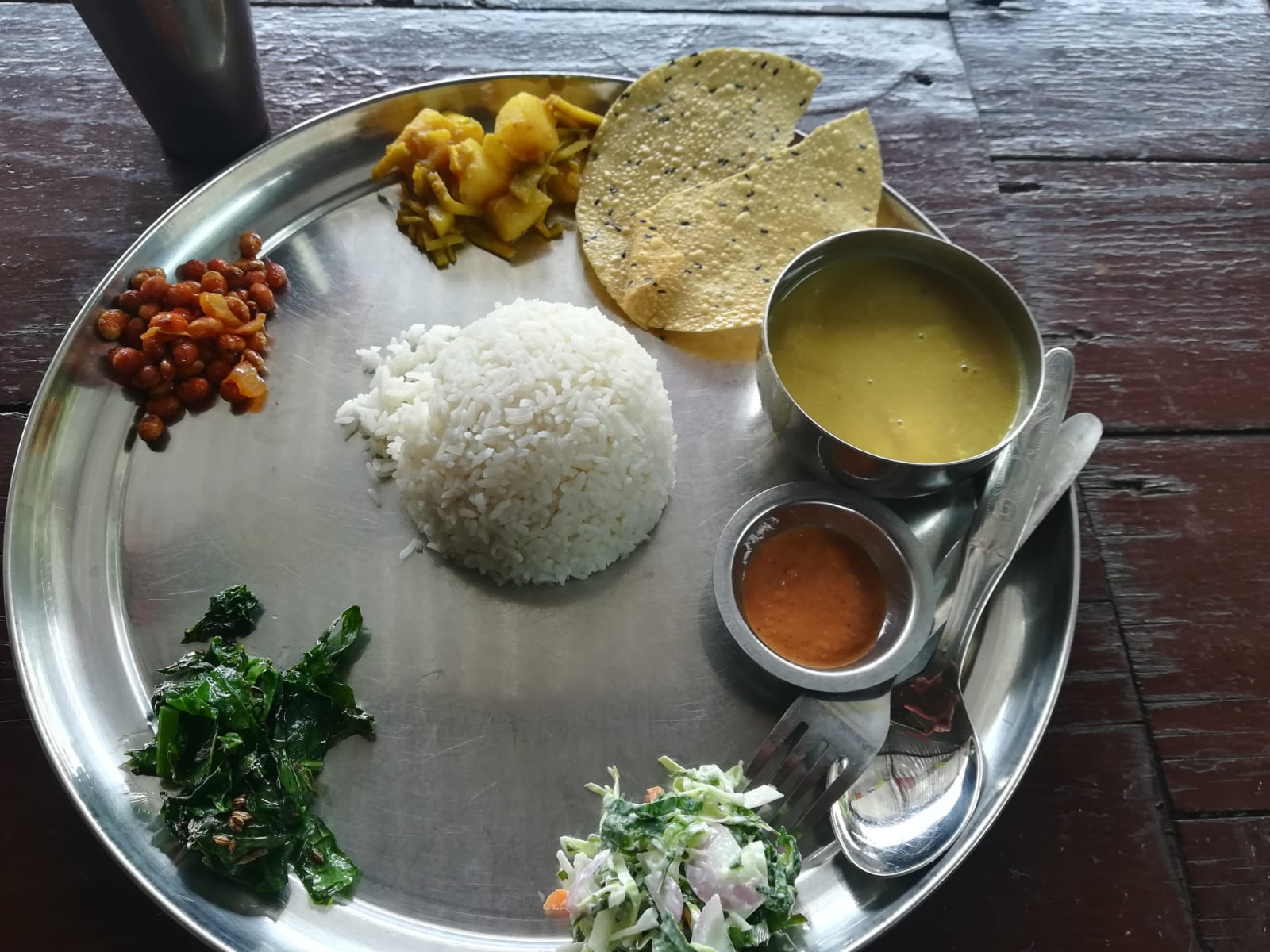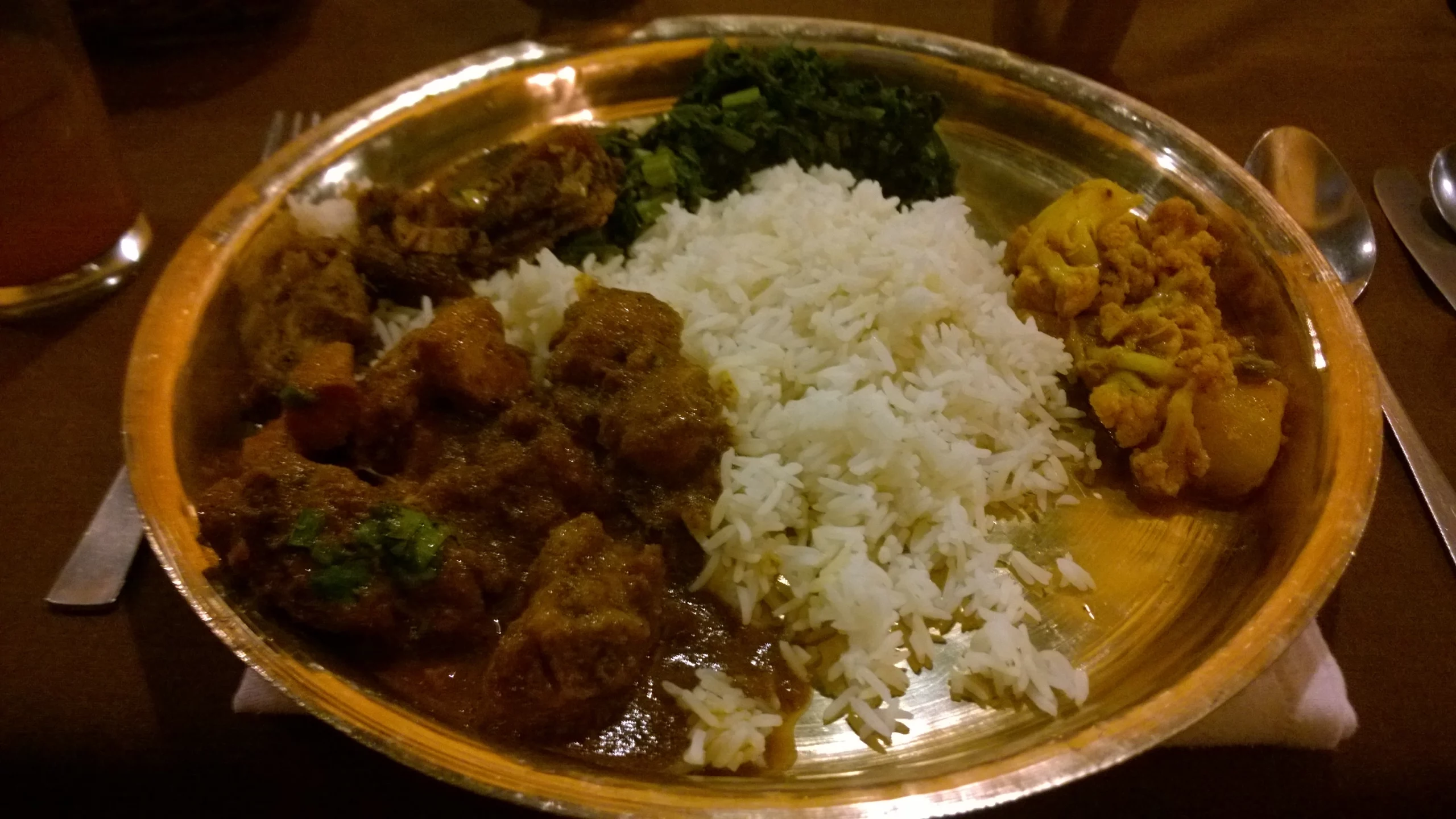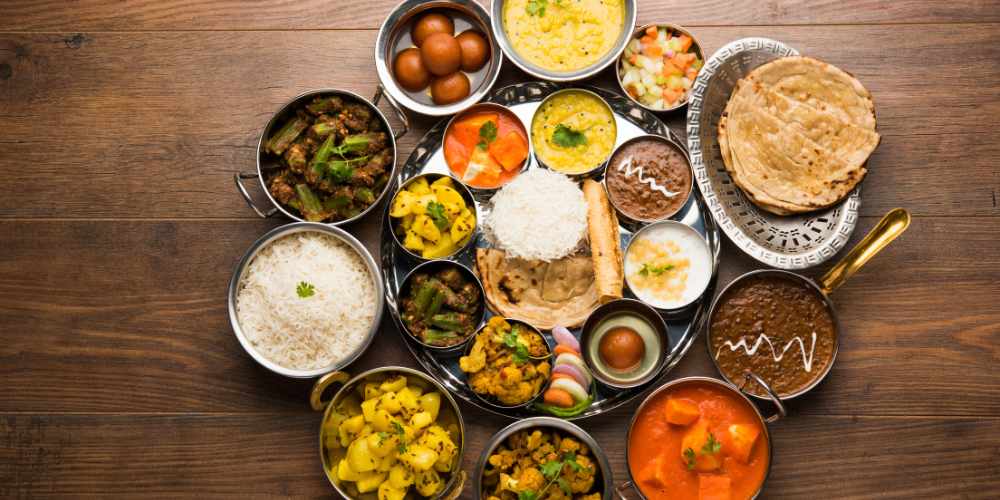Dal Bhat Power 24 Hour

“Dal Bhat Power 24 Hour” is a slogan that many tourists in Nepal are familiar with. It represents one of the country’s most loved dishes, Dal Bhat. This meal is a must-taste for those who enjoy trying new foods. It includes Dal, a flavorful lentil soup, and Bhat, which is steamed rice. Along with this, you can have side dishes like curry, pickles, and spinach depending on where you are.
Dal Bhat is famous for its delicious taste and providing sustained energy. It is eaten twice a day in Nepal, for morning lunch and dinner. This meal is important for Nepali people and loved for its flavors. Tourists should try it when visiting Nepal to experience the local cuisine.
What is Dal Bhat Power 24 Hour?
The saying “Dal Bhat Power 24 Hour” represents how the traditional Nepali dish, Dal Bhat, gives people energy and sustenance. It shows that this meal can provide the strength needed for long treks and physical tasks in Nepal. This phrase captures the idea that Dal Bhat is more than just a meal – it is a source of energy that keeps individuals going throughout the day.
Dal Bhat is a meal that includes two main parts: Dal, which is a soup made from lentils, and Bhat, which is rice that is steamed. When you eat Dal Bhat, you also have side dishes like vegetables, pickles, yogurt, and sometimes local meat or paneer if you are a vegetarian. This meal is not only tasty but also provides a balanced mix of nutrients that give you energy all day long.
 “
“
Dal Bhat Components: What Actually is Dal Bhat?
The motto “Dal Bhat Power 24 Hour” represents Nepal’s rich culture and the energy-boosting qualities of the dish. Dal Bhat is a classic meal in Nepali cuisine that is considered a complete meal because it has carbs, proteins, and other supplements from the side dishes. Nepali Dal Bhat continues to be popular globally because it is simple, nutritious, and delicious.
What is Dal?
Dal is a key dish in Nepali cuisine and it is a kind of lentil soup. It is made from pulses like beans, grams, and peas and is a good source of protein with a delicious flavor. To cook Dal, the lentils are washed well and then cooked until they are tender, usually in a pressure cooker which helps to save time and energy. Turmeric powder, salt, and a couple of drops of oil are added while cooking to improve the taste and color.
To make the dish better, we cook a mix of ghee and cumin seeds until they turn golden brown. We then mix this into the cooked Dal. This step adds a nice smell and improves the taste. Various regions in Nepal may also use spices like coriander, ginger, and garlic to add different flavors.
What is Bhat?
The word “bhat“ means steamed rice. It is a significant part of Nepali cuisine as it supplies carbohydrates. To make bhat, start by washing the rice to remove excess starch, then steam it using a rice cooker or a pressure cooker.
When cooking rice, it is important to use the correct amount of water. If you use too little water, the rice will be undercooked, and if you use too much water, the rice will be soggy. After a few minutes, the rice cooker or pressure cooker will finish cooking, and the rice will be ready to eat. Steamed rice has a mild flavor and pairs nicely with Dal soup.
Side Dishes and Complements
A typical Dal Bhat meal is usually served with various side dishes that enhance the nutritional content and flavor diversity of the food. These side dishes can consist of curries made from local vegetables or meats such as chicken or mutton, which add protein and complexity to the taste. Spicy pickles, mainly Gundruk (fermented leafy greens), offer a tangy contrast to the creamy Dal and neutral rice.
Furthermore, there are fresh salads and greens like spinach that provide a refreshing mix of flavors and important nutrients. You also have the option of choosing fish or paneer for a different source of protein, showcasing how versatile the dish can be for different dietary preferences. Ending the meal on a soothing note, you may be offered locally-sourced yogurt made from milk, adding a creamy sweetness to balance out the savory components of the dish.
The Significance of Dal Bhat in Nepal
Dal Bhat is not just a meal in Nepali culture; it represents the country’s rich culinary history and diverse tastes. The blend of lentils, rice, spices, and side dishes creates a well-rounded and nourishing meal that is essential for good health.
Cultural Importance
Dal Bhat is a key part of Nepal’s culture. It goes beyond just being a meal and is deeply rooted in the daily routines, hospitality, and customs of the country. This dish plays a role in uniting various groups of people in Nepal, showing a common heritage in cooking. For lots of Nepali families, preparing and enjoying Dal Bhat is a way to honor tradition and show pride in their culinary skills passed down through generations.
Celebrations and festivals like Dashain in Nepal often include Dal Bhat on their menus, showcasing its importance across different occasions. It symbolizes the generosity and warmth with which guests are welcomed, offering a true taste of home. Eating Dal Bhat with hands helps create a stronger bond with the food and the convivial experience shared with family and friends.
Nutritional Value
Dal Bhat is an important part of Nepali culture and is also very healthy to eat. It gives energy because it includes proteins, carbohydrates, and important nutrients. Lentils, the main ingredient in Dal, are an excellent source of plant-based protein that is essential for muscle repair and growth. They are also rich in iron, fiber, and B vitamins, which help with overall health and energy production.
Rice provides energy for Nepalis who do physically demanding work. Side dishes like vegetables, meat, or paneer give them vitamins and minerals. Spices like turmeric and ginger not only make the food delicious but also have health benefits.
Overall, Dal Bhat supplies a well-rounded diet that supports sustained physical activity and contributes to the overall wellness of the populace.
Role of Dal Bhai in Daily Life of Nepali People
The importance of Dal Bhat in the daily lives of Nepalis cannot be understated. It is usually eaten twice a day, during lunch and dinner, and is a significant aspect of their diet in both urban and rural regions. Many people feel that a day is not fulfilled without having Dal Bhat. By eating it regularly, individuals can maintain their energy levels for a variety of activities, including farming and trekking.
Besides, Dal Bhat is appreciated not only for its health benefits but also for the comfort it offers. The familiar flavors and scents create a feeling of home and safety, making it a meal that many find comforting and satisfying. Being an affordable and easy-to-find dish, it helps guarantee that everyone has access to nutritious meals.
To summarize, Dal Bhat is crucial in Nepalese life as it reflects their culture, provides essential nutrients, and is a consistent part of their daily routine. Nepalis depend on Dal Bhat for sustenance and to uphold their cultural heritage, showing that it is a powerful symbol of strength and vitality.

Cooking Dal Bhat: A Step-by-Step Guide
Cooking the perfect Dal Bhat requires attention to techniques that bring out the best qualities of each component of the dish. Below is a practical guide to ensure a rich and satisfying Dal Bhat experience.
Step 1: Preparing Bhat (Steamed Rice)
Creating the perfect Dal Bhat requires attention to techniques that bring out the best qualities of each component of the dish.
Follow these simple guidelines to make your Dal Bhat meal experience even more enjoyable.
- To start, measure the amount of rice you want to cook and rinse it under cold water to remove any surface starch. This step will prevent the rice from sticking.
- Once the rice is washed, place it in a rice cooker or pressure cooker and add the proper amount of water. For medium-grain rice, it is best to use a 1:2 ratio of rice to water.
- If you are using a rice cooker, it will stop automatically when the rice is ready. If using a pressure cooker, wait for two whistles to know when the rice is fully cooked. You can also check by making sure the rice grains are tender and the water is absorbed if cooking in a pan.
Step 2: Cooking Dal (Lentil Soup)
Here is how to prepare the Lentil soup:
- Select the type of lentils you prefer – yellow, red, or green are common options. It’s important to wash the lentils thoroughly to get rid of any impurities.
- In a pressure cooker or pot, combine water, turmeric powder, and salt with lentils. Cook for 30 minutes or until lentils are soft.
- Warm up some ghee in a pan. Cook the cumin seeds until they smell good. If you want, you can also add ginger or garlic. Mix this spice mix into the lentils and stir gently.
Step 3: Preparing the Thakali Set (Extra)
Dal Bhat consists of rice and lentils, and when paired with the Thakali set, it becomes a truly delightful culinary treat. It combines a mix of vegetables, pickles, and other condiments to complement the flavors of the Dal Bhat.
Here is how to prepare the Thakali set:
- Begin by preparing a vegetable side dish such as cooked spinach, potatoes, or cauliflower. You can also add a salad with cucumbers, tomatoes, and carrots for a fresh and crunchy flavor.
- Following that, you might want to consider including some spicy pickles and chutneys for added flavor. Mango pickle, tomato chutney, or spicy green chili chutney are commonly chosen.
- To finish the Thakali set, put some yogurt on the plate to balance the spicy and tangy flavors of the meal. Serve all of these side dishes with the Dal Bhat for a truly authentic and enjoyable dining experience.
By following these simple steps, you can create a delicious and wholesome Dal Bhat meal that is sure to satisfy your taste buds and leave you feeling nourished and content. Enjoy the rich flavors and comforting textures of this traditional Nepali dish, and savor every bite of this delicious and nutritious meal.
Experience the Authentic Dal Bhaat, Thakali Set & Other Nepali Cuisine With us

Looking for a true taste of Nepal? Look no further than Namaste Nepal! We are proud to offer an authentic Nepali dining experience that will transport you straight to the bustling streets of Kathmandu.
We provide traditional Dal Bhaat and the famous Thakali Set to our guests who join us for treks or holiday packages. These meals include rice, lentil soup, vegetable curry, pickles, and a choice of meat or fish curry. They are delicious and nutritious, made with fresh ingredients sourced locally.
Experience more than just our food with our guided tours and other options in Nepal. From visiting ancient temples in Kathmandu to trekking through the Himalayas, we cater to all interests.
Come and join us at Namaste Nepal to taste the real Nepali cuisine. Our food journey will give you unforgettable memories and a newfound respect for this beautiful country. With our warm welcome and delicious dishes, we assure you that your time with us will be amazing.
FAQs
What is Dal Bhat?
Dal Bhat is a traditional Nepali meal consisting of rice (bhat) and lentil soup (dal) along with various side dishes such as vegetable curry, pickles, and meat or fish curry.
What is Dal?
Dal refers to lentil soup, which is a staple in Nepali cuisine. It is made by boiling lentils with spices and seasonings to create a flavorful and nutritious soup.
What is Bhat?
Bhat is the Nepali word for rice, which serves as the main component of the meal. It is typically served alongside the dal and other side dishes to create a balanced and filling meal.
What is the meaning of Dal Bhat Power, 24 hour?
Dhal Bhat Power, 24 hour is a popular phrase in Nepal that refers to the energy and nourishment provided by the traditional dal bhat meal. It is often enjoyed by trekkers and locals alike for its ability to fuel the body and provide sustenance during long days.
What are the key ingredients in dal bhat?
The key ingredients in dal bhat include rice, lentils, various spices (such as turmeric, cumin, and mustard seeds), vegetables (such as potatoes, cauliflower, and spinach), and meat or fish for the curry.
How is dal bhat traditionally served?
Dal bhat is traditionally served on a metal plate called a thali, with the rice in the center and the lentil soup and side dishes arranged around it. It is typically eaten with the hands, using the rice to scoop up the dal and other dishes.
What is the significance of dal bhat in Nepali culture?
Dal bhat holds a significant place in Nepali culture as it is a staple meal that is enjoyed by people of all backgrounds and social status. It is considered a symbol of hospitality and is often served to guests as a gesture of warmth and welcome.
How is the Thakali set different from traditional dal bhat?
The Thakali set is a variation of the traditional dal bhat meal that originated from the Thakali people of Nepal. It includes additional side dishes such as roasted meat, pickles, and yogurt to enhance the flavors and textures of the meal.
What makes the Thakali set unique?
The Thakali set is unique for its inclusion of a wider variety of dishes, including meat and yogurt, which add a richness and depth of flavor to the meal. It is a popular choice for those looking to experience a more diverse and indulgent version of the classic dal bhat.
What are the health benefits of dal bhat?
Dal bhat is a nutritious meal that provides a good balance of carbohydrates, protein, and The Thakali set is unique for its inclusion of a wider variety of dishes, including meat and yogurt, which add a richness and depth of flavor to the meal.
How do you make Dal Bhat?
To make Dal Bhat, cook lentils with spices and water until they are soft and creamy. Serve the dal with steamed rice and your favorite side dishes.
Can you customize the Thakali set?
Yes, you can customize the Thakali set by adding your favorite vegetables, pickles, and meats to complement the dal bhat.
What are some common side dishes in a Thakali set?
Some common side dishes in a Thakali set include sautéed spinach, potatoes, lentils, pickles, and various types of curries.
Can I make Dal Bhat without meat?
Yes, Dal Bhat is traditionally a vegetarian dish, but you can also add meat or eggs if you prefer.
How long does it take to cook Dal Bhat?
Cooking Dal Bhat typically takes around 20-30 minutes, depending on the type of lentils and rice used.
What spices are commonly used in Dal Bhat?
Common spices used in Dal Bhat include cumin, coriander, turmeric, garlic, ginger, and chili powder.
Can I make Thakali set for a large group of people?
Yes, you can easily scale up the recipe for Thakali set to feed a large group of people by increasing the quantities of ingredients accordingly.






